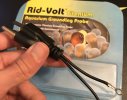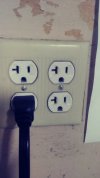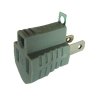View attachment 29103
These are two 20A circuits. Notice the T-neutral on the left; the breaker, smaller right slot must be the Hot/Line; bottom is the ground. The screws holding the wall-plate contact the metal box that has the EMC/metal pipe grounded all the way to the main panel (PG&E service)
The extra clamp on the Titanium Grounding Probe is a redundant grounding point. Some people in older homes, although the wiring is very old and has Line and Neutral wires only, newer plugs were installed that have the grounding point BUT no ground wire; that was done in the wrong manner; a two-prong receptacle has to be used or a GFCI can be placed since they are designed to detect the Ground Fault (or absence of it) and Interrupt the Circuit in milliseconds thus protecting you from electrocution.
The testers are designed to check on the circuit’s proper attachment of the wires. Bigger slot is the Neutral and in the newer plugs, the fastening screw is silver in color, the smaller slot normally has a gold colored screw for the Hot/Line; normally Black wire indicates the hot line but other colors are also used to ID separate circuits. Sometimes DIY-ers reverse these two wires; the tester will indicate a reverse polarity as it will show an open Ground, Hot, Neutral.
A multimeter can be used too, is a much more complete tool to test high and low voltages, amperage, resistance...
All you do is insert the probes and should give you a reading.
I’ve been to quite a few places where the hot and neutral are reversed or where the hot shorted somewhere. I’ve found the most difficult troubleshooting for me is a shorted neutral as they are also known as “common wire”
A friend for years had an extension cord running down to the garage from the kitchen; electricians told him he needed a re-wire of the whole basement and he left at least couple years pass by with that issue. I used both, multimeter and the simple tester; line was hot and the breaker at the box seemed to be in good working order after a visual inspection but still, no power. The circuit was open somewhere so to remove covers; nothing at any of the boxes...
I opened the breaker panel and noticed a neutral wire carbonized and the fastening screw fused to the neutral bonding bar, which prevented the circuit from completing at that point. Clipped the neutral and fastened in an available bonding post; that solved the problem.
The only way my friend tested for power, was to plug something or try to turn lights on; if he have had a simple tester, would have saved him at least a couple e years of running extension cords down to the garage.
Moral of the story is to get a simple wiring tester.





